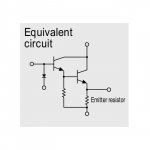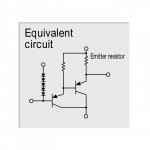Hello again. Have made progress and all probs now seem to be converging. Started with Cambridge amp distorting on left channel. Replaced Darlington power devices (SAP 15s) with SAP 16s on basis that was told they were pin compatible.
Since then have had problem with main power supply fuses (4 amp) persistently blowing. Left channel adjustment variable resistor replaced (open circuit), all other values, resistances checked and found ok.
Close examination shows slight differences between SAP 16 equivalent circuits and SAP 15s shown in schematic.
Questions: 1. Are these differences enough to account for the fuse blowing problem? 2. If so is there a work around I could apply?
Your help much appreciated as ever.
Since then have had problem with main power supply fuses (4 amp) persistently blowing. Left channel adjustment variable resistor replaced (open circuit), all other values, resistances checked and found ok.
Close examination shows slight differences between SAP 16 equivalent circuits and SAP 15s shown in schematic.
Questions: 1. Are these differences enough to account for the fuse blowing problem? 2. If so is there a work around I could apply?
Your help much appreciated as ever.
Attachments
PNP and NPN devices were changed on left channel. SAP 15s shown in schematic were replaced with SAP 16s as shown in attached thumbnails. If you compare these with diagrams in schematic there seem to be minor differences. Question is are these significant in respect of the fuse problem and if so is there a workaround?
Nope, I dont think so. The difference is only where the driver emitter resistors are going.Question is are these significant in respect of the fuse problem and if so is there a workaround?
Although this can affect the bias and maybe the HF behaviour...
Have you readjust the bias before and after replacing the SAPs?
Starting from a low value of course...
If you don't have that N/P configuration correctly with the collectors conected to the + and - rails respectively, you will certainly blow fuses and probably the SAP devices too.
Don't expect accuracy from Sanken's simplified sketch of the internals of their SAP devices. These SAP16 types differ only in the size of the dies so that power can be handled with better reliability than SAP15. Actually, no one gives a hoot what Sanken uses for thumbnails, so long as it shows the distinct pin functions at a glance.
The datasheets will give the full detail needed for design purposes or curiosity, if you wish to know more about the internals of these unique Darlingtons with their independent, thermally tracking bias system. SAP15 Datasheet pdf - Darlington transistors with built-in temperature compensation diodes for audio amplifier applications - Sanken
Don't expect accuracy from Sanken's simplified sketch of the internals of their SAP devices. These SAP16 types differ only in the size of the dies so that power can be handled with better reliability than SAP15. Actually, no one gives a hoot what Sanken uses for thumbnails, so long as it shows the distinct pin functions at a glance.
The datasheets will give the full detail needed for design purposes or curiosity, if you wish to know more about the internals of these unique Darlingtons with their independent, thermally tracking bias system. SAP15 Datasheet pdf - Darlington transistors with built-in temperature compensation diodes for audio amplifier applications - Sanken
The SAP16's should replace the SAP15's directly without trouble. It's quite likely you have a problem somewhere else in the amp. It's quite probable that there is damage to the predriver or VAS stage, at least judging by the Cambridge amp's ive repaired when the SAP's let go...
Problem Solved!
Have found the cause of my fuse blowing problem!
Was a process of elimination, by disconnecting channels and other connectors from power supply eventually reduced it to rectifier and smoothing capacitors.
Problem had to be a blown capacitor. Replaced and now all is working!
Last issue is adjustment of quiescent current setting.
Required 13mv too small for my (analog) meter, any ideas how to adjust?
Thanks again
M
Have found the cause of my fuse blowing problem!
Was a process of elimination, by disconnecting channels and other connectors from power supply eventually reduced it to rectifier and smoothing capacitors.
Problem had to be a blown capacitor. Replaced and now all is working!
Last issue is adjustment of quiescent current setting.
Required 13mv too small for my (analog) meter, any ideas how to adjust?
Thanks again
M
Required 13mv too small for my (analog) meter, any ideas how to adjust?
You could build a low-offset op amp based diff-amp circuit, with a DC gain of 100 times to get 1.3VDC.
If you still don't trust your meter, then adjust the diff-amp gain for 1.56VDC (a gain of 120 times),
and compare the reading to a fresh D cell, which should be the same.
Last edited:
It would be much easier just to buy a cheap meterYou could build a low-offset op amp based diff-amp circuit, with a DC gain of 100 times to get 1.3VDC.
If you still don't trust your meter, then adjust the diff-amp gain for 1.56VDC (a gain of 120 times),
and compare the reading to a fresh D cell, which should be the same.
It would be much easier just to buy a cheap meter
Yes, but that wasn't the question.
A DMM with just enough accuracy can be bought for peanuts even on market stalls in the UK. Buy one suited to electronics as opposed to automotive use, as a lot of electronic tinkering will now call for one.
BTW folks, how's this for cheap, complete with transistor test, even if it is cr*p Digital LCD Multimeter Voltmeter Ammeter Ohmmeter OHM Capacitance AC DC Tester | eBay It will be cheaper to do this than buy the parts to make up almost any circuit and power supply.
Digital LCD Multimeter Voltmeter Ammeter Ohmmeter OHM Capacitance AC DC Tester | eBay It will be cheaper to do this than buy the parts to make up almost any circuit and power supply.
BTW folks, how's this for cheap, complete with transistor test, even if it is cr*p
The thread is about repairing SAP15 outputs. With a meter with diode test, the OP could tell a lot about the health of those transistors and the suspect drivers.Yes, but that wasn't the question.
- Status
- This old topic is closed. If you want to reopen this topic, contact a moderator using the "Report Post" button.
- Home
- Amplifiers
- Solid State
- Cambridge SAPs and Fuses blowing

